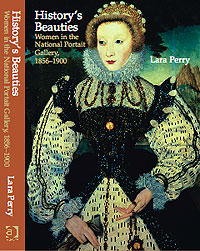Two new publications from staff in the School of Historical and Critical Studies
15 Aug 2013
 Two pioneering monographs from staff in the School of Historical and Critical Studies are being published this year. Louise Purbrick, who works on material and visual culture from the nineteenth to the twenty-first centuries, will shortly welcome her book The Wedding Present: Domestic Life Beyond Consumption. Lara Perry, who researches nineteenth-century art and culture, received the first copies of her book, History’s Beauties: Women and the Nineteenth-Century National Portrait Gallery, earlier this year.
Two pioneering monographs from staff in the School of Historical and Critical Studies are being published this year. Louise Purbrick, who works on material and visual culture from the nineteenth to the twenty-first centuries, will shortly welcome her book The Wedding Present: Domestic Life Beyond Consumption. Lara Perry, who researches nineteenth-century art and culture, received the first copies of her book, History’s Beauties: Women and the Nineteenth-Century National Portrait Gallery, earlier this year.
These two books exemplify different approaches to multi-disciplinary research in the history of visual and material culture, and will contribute to the growing reputation of the Faculty for work of this kind. In The Wedding Present, Louise Purbrick offers an alternative analysis of contemporary domestic consumption. She investigates the ritualized presentation of objects upon marriage, and their subsequent cycles of exchange within the domestic sphere. Focusing on gift-giving in Britain from 1945 to the present, the book is based on research specially commissioned from the Mass Observation Archive, with comparative con¬text provided by material from North America and Europe. By considering how the specific contexts in which consumption occurs, such as married domesticity, can limit possible versions of selfhood, The Wedding Present tests the assumption that consuming creates individual identities. The book makes significant historical, theoretical and methodological contributions to the analysis of contemporary consumption; it also re-evaluates consumption theory as well as examining the methodology of recent studies in consumption and domesticity, pressing for a more rigorous approach to the use of case studies.
The first monograph study of gender in a major museum, History’s Beauties: Women and the Nineteenth-Century National Portrait Gallery, deploys analysis of gender, national identity, class cultures and aesthetics in Victorian England to interpret the National Portrait Gallery’s early collection. The study is based on the first major research on the National Portrait Gallery’s collection, and focuses on its collection of women’s por¬traits (both as sitters and as artists) during the first forty-five years of the Gallery’s history. The book analyses this collection in relation to three principal themes: portraits of the Royal family and the cult of legitimacy; the educated woman as a model of domestic and national cultivation; and the role of female beauty in defining social and artistic power in nineteenth-century Britain. The text studies in detail individual examples of portraits, their display, and critical evaluation by the Gallery’s administrators, and considers them in relation to the ‘representation’ of women in the politi¬cal cultures from which the NPG emerged. Engaging with debates from various disciplines, including museum studies, women’s history, and art history, History’s Beauties contributes particularly to growing literature on women’s role in the Victorian public sphere, and to the place of portraits in Victorian taste. Early reviews of both books suggest that they will be welcomed by colleagues as exemplary studies of their kind. Both books are, coincidentally, published by Ashgate Press, and more information about them can be found on the press website, www.ashgate.com.